 |
 |
|
 |
 |
The 85th in Italy: Official Unit History
Volturno River
 On 17 October 1943 Company ‘A’ assisted by the Detachment constructed a class 40 Heavy Ponton Bridge across the Volturno River
On 17 October 1943 Company ‘A’ assisted by the Detachment constructed a class 40 Heavy Ponton Bridge across the Volturno River
- 10/13/43 Italy declares war on Germany. On 17 October 1943 Company ‘A’ assisted by the Detachment constructed a class 40 Heavy Ponton Bridge across the Volturno River in the vicinity of Trifilisco to replace a M-1 steel treadway
bridge already in place. The replacement of bridges proved conslusively that the ponton bridge could handle a greater amount of traffic than the other bridge. When the treadway bridge was in place, vehicles were lined up from two to three miles on both sides
of the river waiting to cross. However, with the ponton bridge in place, the bottleneck was broken and never reappeared. On 22 October 1943, a traffic count was taken for a 24 hour period and it was found that 2334 vehicles and 1770 pedestrians had used the
bridge. This bridge was the first Heavy Ponton Bridge built in the European theater. The following facts, which are contrary to the normal operation of a bridge, are submitted.
1. Traffic up to 4 ton loads was
allowed to travel 25 to 30 miles per hour. This was possible because of smooth approaches and a minimum change in slope from the abutment span to the floating spans. The increased traffic speed, although it increased the maintinance of the bridge, made possible
almost double the volume of traffic that would normally cross at the standard speed of 10 to 15 miles per hour.
2. Class 60 loads were allowed to cross this bridge. The loads were tank transporters M-19 loaded
with M-10 tanks, and were allowed to cross at 3 miles per hour. A total of five such loads crossed during the time the bridge was in operation without danger of damage to the bridge.
3. Complete decking with
2” lumber nailed to the chess was necessary to sustain the wear and tear of traffic.
On 26 October 1943, the Detachment established the Fifth Army tactical bridge depot in the vicinity of Triflisco. The
depot was operated directly under the Army Engineer and furnished bridging to the Corps by means of bridge trains. The bridge trains were directly under the control of the Corps Engineer who designated where the bridges were to be constructed. When the vehicles
of the train delivered equipment to the bridge site, they automatically returned to the depot to refill their vehicles. The bridge trains bivouaced in the vicinity of Corps Headquarters to facilitate control by the Corps Engineer. The bridge depot was not
a base depot but a tactical depot with its stocks kept to a minimum in order to expedite movements. The depot stocked fixed and floating bailey bridges, steel treadway bridges, infantry support bridges, heavy ponton bridges and other stream crossing equipage.
On 26 October 1943 an officer from the Detachment was placed on temporary duty with the Fifth Army Engineer Headquarters to act as technical adviser on all types of floating bridges and fixed bailey bridges. An officer
remained at Fifth Army Headquarters until the unit was assigned to Seventh Army.
Company ‘A’ constructed a class 40 trestle bridge 90 feet long in the vicinity of Venafro on 15 November 1943. The
bridge was used for seven days and then dismantled.
The floods on the Volturno River damaged the fixed pile crib bridges at Triflisco constructed by the 343rd Engineer General Service Regiment. On 16 November
1943, Company ‘A’ furnished a class 40 raft to be used in the repair of this bridge. The cribs around the piles were built higher and the raft was used for carrying dump trucks loaded with rocks to the cribs of the bridge.
The first bridge platoon of Company ‘A’ was attached to II Corps to operate the Corps bridge train on 22 November 1943. It was determined by unloading the ponton equipage and reloading with bailey bridge equipage that either
two panel loads, two decking loads or two ramp loads could be carried on one standard heavy ponton semi-trailer. The accessory load could readily be transported in the cargo box of the prime mover. As the standard British bailey bridge consists of 10 panel
loads, 8 decking loads, 4 ramp loads and 2 accessory loads, it was required that 11 prime movers with semi-trailers be used to transport this bridge. With the standard British Bailey Bridge, sufficient equipment is available to construct either one 150 feet
double double bridge or two 80 feet double single bridges. - 11/28/43 Roosevelt, Churchill,
and Stalin meet at Teheran.
The Detachment moved the Fifth Army Bridge depot from Triflisco
to the vicinity of Vairano on 10 December 1943.
A class 40 raft, used as a ferry, was constructed to aid the 337th Engineer General Service Regiment in the erection of a bailey bridge in the vicinity of Piedmonte
on 27 December 1943.
On 28 December 1943 a class 40 raft, used as a ferry, was constructed to aid the 343rd Engineer General Service Regiment in the erection of a bailey bridge in the vicinity of Ravisiania.
- 1/6/44 Soviet troops advance into Poland. - 1/17/44 First attack toward Cassino, Italy.
On 30 December 1943 the first bridge platoon acting as bridge train for II Corps was relieved and attached
to VI Corps with the same mission. From 14 January to 17 January 1944, the bridge train platoon was attached to the French Corps at the end of which time they were relieved of attachment and returned to their Company.
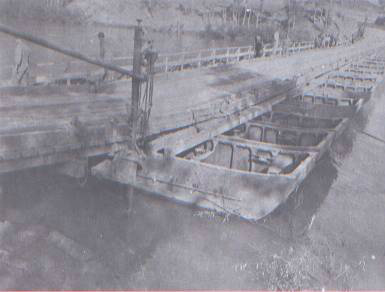 a traffic count was taken for a 24 hour period and it was found that 2334 vehicles and 1770 pedestrians had used the bridge.
a traffic count was taken for a 24 hour period and it was found that 2334 vehicles and 1770 pedestrians had used the bridge.
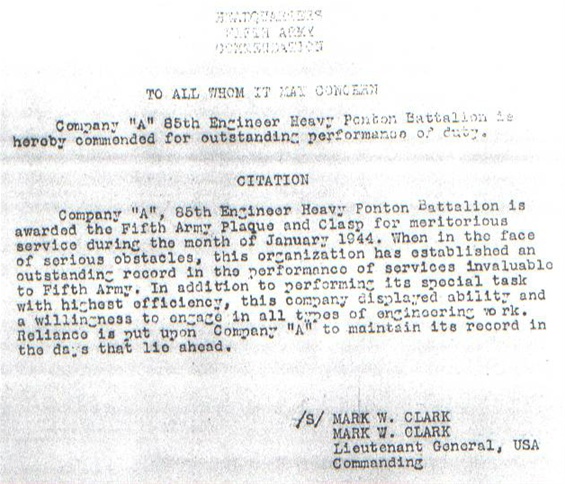 Letter of commendation from Gen. Mark Clark regarding the performance of the 85th during January of 1944
Letter of commendation from Gen. Mark Clark regarding the performance of the 85th during January of 1944
The Death of Sgt. Kramer
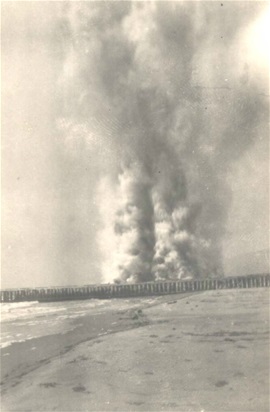 Teller mines clear the channel at the mouth of the Volturno for transporting Gen. Clark
Teller mines clear the channel at the mouth of the Volturno for transporting Gen. Clark
- 1/22/44 Allies land at Anzio. - 2/15 tp 2/18/44 Allies bomb the monastery at Monte Cassino. From 26 January to 18 February 1944, the storm boat section of the Detachment in the vicinity of Castel Volturno was given the mission of transporting the Commanding General of Fifth Army Mark Clark and his staff, by means of storm boats
to a PT boat anchored off the coast of Italy. The PT boat when loaded departed for the Anzio beachhead. When the boat returned, the storm boats picked up the passengers and brought them to shore.
On
28 January 1944, Company ‘A’ began construction of a truck control tower for the Fifth Army railhead at Vairano. The job was completed on 1 February 1944.
One platoon of Company ‘A’
with two R-4 bulldozers began grading an area for the Quartermaster bakery on 3 February 1944. The job was completed in two days.
During the period from 10 February to 24 April 1944, Company
‘A’ demonstrated the construction of the heavy ponton bridge and construction and operation of a class 40, five boat ponton raft to the students attending the School of Military Engineering (British) at Capua. Each demonstration lasted one day
and nine demonstrations were made for the school during this period.
On 11 February 1944, Company ‘A’ constructed a seven boat ponton raft, complete with landing stages to aid the
357th Engineer General Service Regiment in the erection of a double bailey bridge in the vicinity of Cancello on the Volturno River. The raft was constructed under blackout conditions. While unloading equipment for the raft, a prime mover and trailer became
stuck and a bulldozer was called to the river bank to pull the vehicle up to the hard standing ground. The bulldozer ran over a double teller mine, throwing the operator through the air but causing him no injuries. The sergeant standing next to the dozer at
the time of explosion, was thrown into the river and the driver of the prime mover was injured. Sergeant Leaonard J. Kramer, 35017716 was in charge of unloading the bulldozer and pulling the prime mover from the river bank. He was walking directly in front
of the bulldozer directing its movements, necessary due to blackout. After the tremendous explosion no trace whatsoever could be found of Sergeant Kramer. A thorough search was made of the banks and the river but no trace of the sergeant could be found. The
following morning the area was again searched and all that could be found of the missing sergeant was a small piece of his helmet with the Battalion insignia painted on it. He was reported as missing in action and at a later date as killed in action. The sergeant
and the truck driver received the Purple Heart Award.
 Steve Puto received the Purple Heart for wounds received in the explosion that killed Sgt. Kramer
Steve Puto received the Purple Heart for wounds received in the explosion that killed Sgt. Kramer
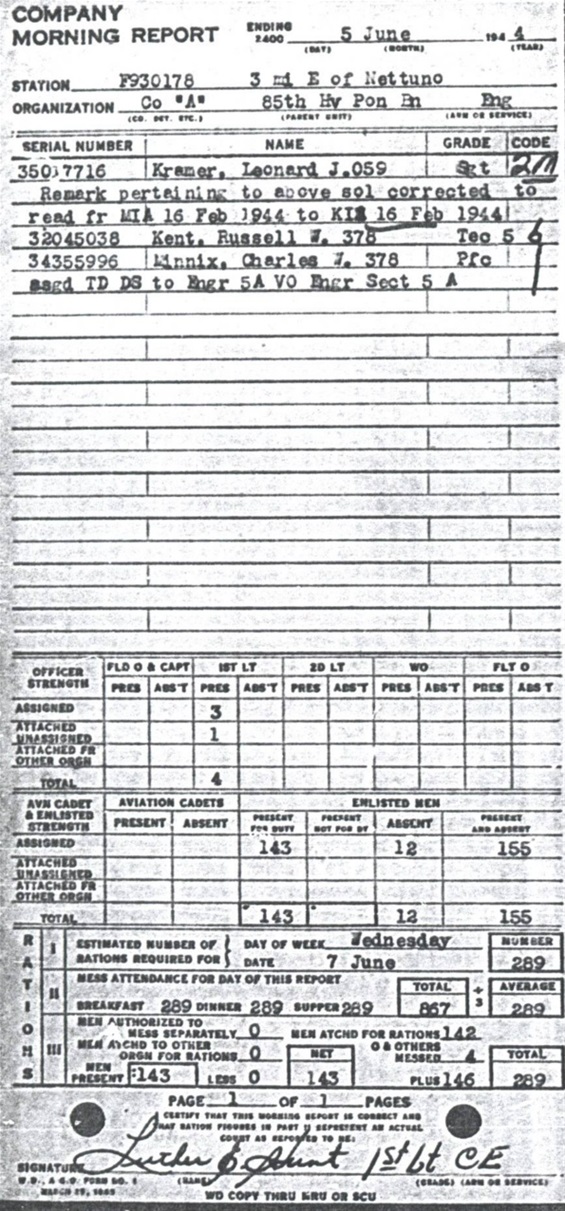 Morning Report noting the death of the 85th's first KIA, Leaonard Kramer
Morning Report noting the death of the 85th's first KIA, Leaonard Kramer
Artillary Fire at the Garigliano
 Company ‘A’ began work on the rebuilding of an Italian home to be used upon completion as a signal repeater station on 13 February 1944. Improvised dump truck
Company ‘A’ began work on the rebuilding of an Italian home to be used upon completion as a signal repeater station on 13 February 1944. Improvised dump truck
Company ‘A’ began work on the rebuilding of an Italian home to be used upon completion as a signal repeater station on 13 February 1944. The building had been destroyed by both American and
German artillery shells and the only thing standing was a portion of the four walls. The bridge depot at this time had a battalion of Italian soldiers working for them. From this Italian unit, ten masons were discovered and attached to Company ‘A’
to be used in the reconstruction of the building. The building was completed on 4 March 1944.Two five boat, class 40 rafts were constructed to aid the 92nd Engineer General Service Regiment in the repair of the fixed pile bridge at Capua on 14 February 1944.
The rafts were maintained by the bridge company.
On 14 February 1944, Lt. Col. L. A. Perdue (then Major) , the Commanding officer of the 85th Engineers, departed from Italy for North Africa where
he established a Floating Bridge School. The purpose of the school was to train two newly activated Heavy Ponton Battalions in the construction, operation and maintenance of the ponton bridge and their basic T/O duties. These two battalions were organized
from the 2nd Cavalry Division. The 40th Engineer Combat Regiment was trained in the Floating Bailey Pontoon Bridge. All other American Engineer units in North Africa were trained in the Floating Bailey Pontoon Bridge as time permitted. Company ‘D’
of the 378th Engineer Battalion (Separate) was reorganized as a Treadway Bridge Company and trained in the construction, operation and maintenance of the steel treadway bridge. Experiments were conducted in construction of dummy camouflage ponton bridges and
on net barriers for protection of bridges against floating mines. - 2/16/44 Germans counter-attack against the Anzio beachhead.
On 28 February 1944,
two class 40 bailey bridges were erected in the vicinity of Teano. One bridge was 90 feet T/S construction and the other 60 feet D/S construction. - 3/4/44 First major daylight bombing raid on Berlin by the Allies.
Company ‘A’ constructed three culverts in the vicinity of Teano on 3 March 1944. - 3/15/44 Second Allied attempt to capture Monte
Cassino begins. On 17 March 1944, one platoon of Company ‘A’ began to maintian a bailey pontoon bridge in the vicinity of Damiano on the Garigliano River. The Damiano site was one of
the five bailey pontoon bridges across across the Garigliano which were under German artillery fire. In order to avoid detection, the platoon constructed a camouflage ponton bridge approximately 100 yards down-stream of the existing bridge. From the completion
time of the camouflage bridge, the actual bridge received little attention from the enemy whereas the downstream bridge drew almost all of the fire. The platoon was relieved on 13 April 1944.
The
Detachment moved the Fifth Army bridge depot to the vicinity of Sessa on 20 March 1944.
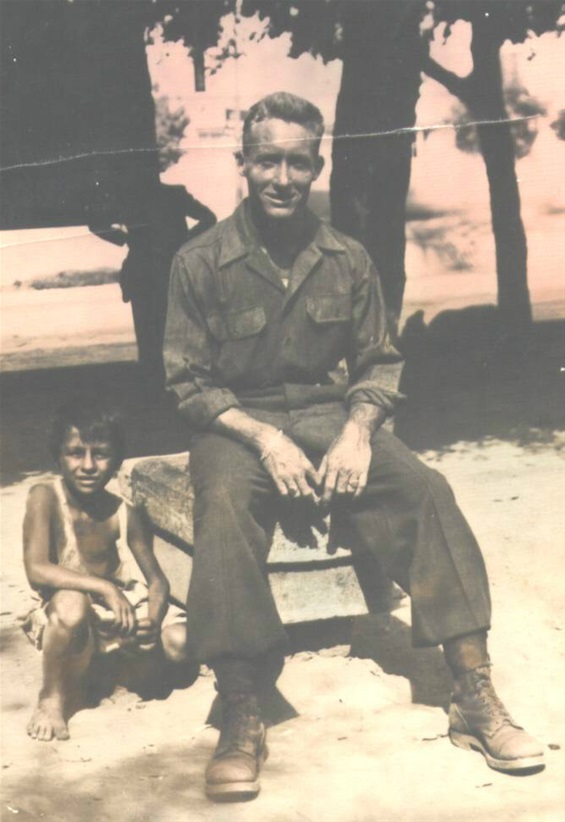 Mel O'Barr, seen here with Italian orphan, survived an 88 shell which slid to a stop near where he lay on the Bailey pontoon bridge. A dud
Mel O'Barr, seen here with Italian orphan, survived an 88 shell which slid to a stop near where he lay on the Bailey pontoon bridge. A dud
Bridging Garigliano River
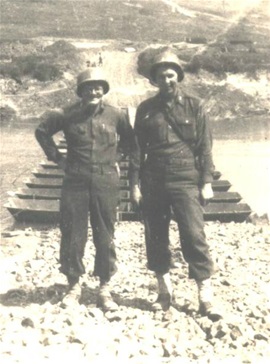 Officers Hunt and Brand stand at the approach to the infantry support bridge across the Garigliano River
Officers Hunt and Brand stand at the approach to the infantry support bridge across the Garigliano River
On 2 April 1944, at 2100, the first platoon of Company ‘A’ started construction of a 180 foot Infantry Support Bridge on the upper Garigliano river. The bridge site was under direct enemy observation
which necessitated building the bridge during blackout. The bridge was completed and open for traffic at 0200 hours the following day. During the daylight hours, a smoke screen was utilized and no vehicles were permitted to use the bridge.
In order to facilitate the French Engineers taking over the maintenance of the infantry support bridge, a demonstration was given showing the French soldiers how to replace damaged assault boats and plywood
treadways. After the demonstration, a small crew of French soldiers were left at the site to further become familiar with the bridge maintenance. One member of the French maintenance party discovered along the bank of the river a German drifting mine. He picked
it up by the aerial and reported the fact of finding the mine to his commanding officer. A French Captain and Lieutenant came to look at the newly discovered mine. The Captain told the Lieutenant to step back while he disarmed the mine. The mine exploded,
killing the French officer. As further protection against drifting mines, five barriers were placed upstream. The barriers were made of camouflage nets and extended at an angle of 45 degrees across the river. Fifty (.50) caliber machine guns were set up to
explode the mines when they failed to detonate upon hitting one of the barriers. Several mines were obtained without exploding and turned over to the proper authorities.
The radio operators of
the Headquarters Detachment were given the mission of operating a bridge warning system on the Garigliano river. Radios (SCR 284) were placed at every other bridge site with telephones connecting the other bridges into the warning system. The net control station
was located at the Fifth Army bridge depot from which point materials and men could be expeditiously sent to the river. Besides the possibiltiy of the bridges being shelled, there was also the danger involved of a sudden rise in water if the Germans demolished
the dam on the Liri river. The system operated very satisfactory although the dam was never blown. On 9 April 1944, the 85th Engineers were given the mission of making a channel at the mouth of the Volturno River to allow the Commanding General’s Chris-Craft
boat to come in and out of the river. A three foot channel was created by detonating teller mines on the bed of the river. The wave action from the sea would soon refill the channel and for this reason the operator of the boat was instructed to run back and
forth through the channel for 30 minutes each day. The action of the boat passing over the channel, kept the channel open.
Company ‘A’ was presented the Fifth Army Plaque for outstanding
performance of duty for the month of January 1944. General Bowman, The Fifth Army Engineer, made the presentation on the 22nd of April 1944 and then inspected the ranks and the company area.
 Officers of the 85th pose with the 5th Army Plaque
Officers of the 85th pose with the 5th Army Plaque
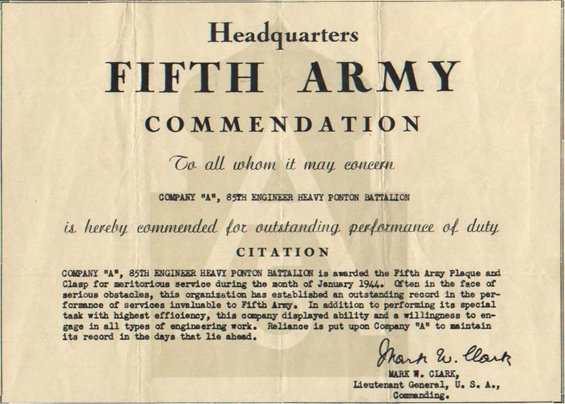 Add photo text
Add photo text
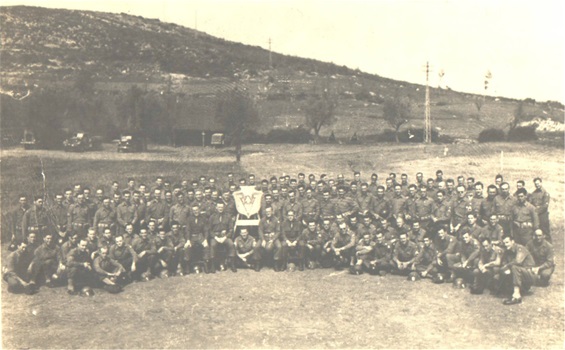 Company A poses with the 5th Army award
Company A poses with the 5th Army award
Heavy Ponton Across the Garigliano
 J.B. "Shrapnel" Johnson stands below a shrapnel hole in a ponton
J.B. "Shrapnel" Johnson stands below a shrapnel hole in a ponton
Company ‘A’ replaced the infantry support bridge across the Garigliano river by constructing a class 28 heavy ponton bridge on 30 April 1944. The bridge was built under the cover of darkness.
The bridge was 180 feet long and actual construction time was four hours. One platoon remained at the site to maintain the bridge.
On 5 May 1944, a German artillery barrage was aimed at the ponton
bridge. One shell landed directly on the bridge and several others close by. Five pontons were replaced and the other boats were repaired in place with temporary patches. As the barrage occurred during the daylight hours, there was no delay in traffic as the
bridge was open by nightfall. - 5/11/44 Allies attack the Gustav Line south of Rome.
The enemy again shelled the ponton bridge on the Garigliano river
damaging eight pontons on 13 and 14 May 1944. One man received the Purple Heart Award when hit in the shoulder by a shell fragment. - 5/15/44 Germans withdraw to the Adolf Hitler Line.
On 16 May 1944, the ponton trailers were unloaded and were used to haul steel beams for a fixed bridge being constructed across the Garigliano river by the 344th Engineer General Service Regiment.
A five boat ponton raft was constructed to aid the 337th Engineer General Service Regiment in the construction of a fixed bridge across the Garigliano river in the vicinity of Minturno on 17 May 1944. Two welders with their equipment
were also furnished to assist in the construction of this bridge. The welders were from the Headquarters Detachment.
On 22 May 1944, the class 28 Heavy Ponton Bridge across the Garigliano river
was dismantled.
The Detachment closed the existing depot and established a bridge depot in the vicinity of Itri, Italy on 23 May 1944. Five days later the Itri depot was closed and the bridge
depot moved forward to Nettuno, Italy. - 5/25/44 Germans retreat from Anzio.
 Company ‘A’ replaced the infantry support bridge across the Garigliano river by constructing a class 28 heavy ponton bridge on 30 April 1944
Company ‘A’ replaced the infantry support bridge across the Garigliano river by constructing a class 28 heavy ponton bridge on 30 April 1944
Tiber River
On 28 May 1944, the bridge company moved their equipage forward in the vicinity of Nettuno in anticipation of crossing the Tiber River. One unit of bridging was unloaded and the vehicles departed for Aversa
to refill and return to Nettuno.
During the period from 29 May to 5 June 1944, Company ‘A’ maintained a network of roads in the vicinity of Anzio. - 6/5/44 Allies enter Rome. - 6/6/44 D-Day landings at Normandy France.
On 6 June 1944, Company ‘A’ constructed a class 40 heavy
ponton bridge across the Tiber River. The bridge was 305 feet long and on the main supply route. Several artillery barrages delayed the construction of the bridge. The 85th Engineers were given the mission of maintaining the ponton bridge, two steel treadway
bridges and a footbridge across the Tiber river.
Another bridge depot was established in the vicinity of Civitavecchia on 12 June 1944. Eleven days later this depot was closed and a new bridge
depot opened in the vicinity of Grosseto.
The two steel treadway bridges and the footbridge were dismantled on 13 June 1944. Three days later the ponton bridge was dismantled. On 20 June 1944,
Company ‘A’ constructed a five boat raft to assist the 343rd Engineer General Service Regiment in the construction of a fixed bridge across the Albergno river. - 6/27/44 U.S. troops liberate Cherbourg,
France.
During the period 20 June to 28 June 1944, Company ‘A’ transported 60ft bridge piles for the 343rd Engineer General Service Regiment. The round trip totaled approximately
700 miles. One platoon dismantled a German Herbert bridge on 28 June 1944. On 1 July 1944, a detail under the supervision of Sgt. Opaska began construction of a single span fixed bridge which was completed 4 July 1944, length 40 feet. - 6/3/44 Battle of the Hedgerows in Normandy. - 7/9/44 British and Canadian troops capture Caen.
During the period 4 July to 15 July 1944,
Company ‘A’ repaired British motor tugs for the bridge depot.
Pursuant to authority contained in Section II, General Order #112, Headquarters Fifth Army, dated 7 July 1944, Company
‘A’ was reorganized under the latest T/O & E, 5-277 dated 9 July 1943, which reduced their enlisted strength from 161 to 130 men. Date of completion of this reorganization was 11 July
 On 6 June 1944, Company ‘A’ constructed a class 40 heavy ponton bridge across the Tiber River. The bridge was 305 feet long and on the main supply route. Several artillery barrages delayed the construction of the bridge
On 6 June 1944, Company ‘A’ constructed a class 40 heavy ponton bridge across the Tiber River. The bridge was 305 feet long and on the main supply route. Several artillery barrages delayed the construction of the bridge
7/11 to 7/14/44
 Diamond T Wrecker
Diamond T Wrecker
On 11 July 1944, 1st Bridge Platoon of Company ‘A’ left the company to construct a bridge and repair a road on Route #73, in the vicinity of Siena,
Italy.
During the period of 15 July to 19 July 1944, the 2nd Platoon was transporting bridge equipment from Bridge Depot E2-23 to E2-27 and piling from Bridge Depot E2-8 located in the vicinity of Vairano, Italy to Engr Depot E2-27 in the vicinity
of Piombino, Italy.
Much assistance was given by Company ‘A’ in the hauling of the bridging equipment between the bridge depots.
In addition to its other duties, the Detachment also operated a wrecker service, utilizing the
10 ton wrecker which pulled as high as three wrecks from the highways in one day.
Det Hq & Serv. Co., 85th Engr Hv Pon Bn engaged in the operation of Fifth Army Bridge Depot E2-25.
The Det. relieved from Depot duties 14 July 1944
and 1 Officer and 35 EM were given a five (5) day rest in Fifth Army Rest Center (Roma).
 85th Engineers at rest camp
85th Engineers at rest camp
From the 5th Army to the 7th Army
- 7/18/44 U.S. troops reach St. Lo. - 7/20/44 German assassination attempt on Hitler fails. Returning from Rest Center 19 July 1944 to vicinity of Orbettelo, Italy, Det. unit was ordered to prepare to rejoin parent unit (85th Engr Hv Pon Bn) on 25 July 1944. On 24 July, moved by motor convoy from vicinity of Sabaudia, Italy departing at 0600 hours. Arrived in the vicinity of Francolise, Italy at 1000 hours. Met by Lt. MacNutt with advance party from Company ‘B’, 85th Engr Hv Pon Bn.
Established CP and bivouac area assigned by Capt. Porter. The Det. proceeded to prepare a bivouac area for Bn Hqs and H&S Company. At 0001 25 July 1944, Det. was
reld from assignment to the Fifth Army and assigned to AFHG, attached to Seventh Army for training, planning, administration and to SOS NATOUSA for supply.
 Companies A and H&S are ordered to prepare to rejoin parent unit (85th Engr Hv Pon Bn) on 25 July 1944. On 24 July, moved by motor convoy from vicinity of Sabaudia, Italy departing at 0600 hours. Arrived in the vicinity of Francolise, Italy at 1000 hours. Note order to prevent firing at telephone poles. After all these were young men! Also, note instruction to remove all unit insignia for secrecy.
Companies A and H&S are ordered to prepare to rejoin parent unit (85th Engr Hv Pon Bn) on 25 July 1944. On 24 July, moved by motor convoy from vicinity of Sabaudia, Italy departing at 0600 hours. Arrived in the vicinity of Francolise, Italy at 1000 hours. Note order to prevent firing at telephone poles. After all these were young men! Also, note instruction to remove all unit insignia for secrecy.
 Orders transferring the 85th from the 5th Army to the 7th Army
Orders transferring the 85th from the 5th Army to the 7th Army
In Summary: Company A in Italy
The following is a summation of the performance of the 85th Engineers Company ‘A’ and the Detachment during the Italian Campaign written by First Lieutenant
J. Q. Irwin: Throughout
the Italian campaign up until August 1944, the Detachment and Company ‘A’ were always on the move in Italy. They ran bridge dumps necessitating much motor convoy work necessary for hauling materials. Records of the marches and travels of these
two outfits are few and indefinite. From conversations with original members of Company ‘A’ and the Detachment, it was discerned that the vehicles were in continual use throughout the winter and there were never any major breakdown of equipment.
Mud was the big problem but the vehicles proved themselves worthy to meet and beat any obstacles when handled properly and maintained correctly. The mens morale was continually high and although the men were called on numerous times to perform many tasks they
completed them all, whether they were jobs for engineer troops or not, and Company ‘A’ was presented with the Fifth Army Plaque and clasp for outstanding performance of duty.
The Battalion Re-united
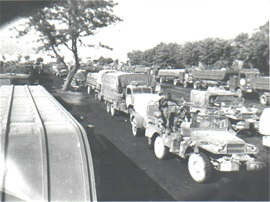 The unloading of the vehicles and the disembarking of personnel was completed at 1300 hours.
The unloading of the vehicles and the disembarking of personnel was completed at 1300 hours.
(Italy - parent unit) The unit sailed from the harbor at Salerno, Italy, at 0300 hours, on 25 July 1944, and arrived at the harbor of Pozzuol, Italy at 0800 hours. The unloading of the vehicles and the
disembarking of personnel was completed at 1300 hours. The unit left the port of Bagnoli, Italy and arrived in the vicinity of Francoliso, Italy at 1800 hours. The distance traveled was 30 miles by motor convoy.
On 25 July 1944, Company ‘A’ and the Detachment of Headquarters and Service Company rejoined the parent unit (Battalion) in the vicinity of Francoliso, Italy and once more the Battalion was complete. Preparations made to assign
personnel and equipment to H&S Company.
The Det. was reld from assignment AFHQ and atchmt, Seventh Army Personnel assigned to H&S Company, 85th Engr Hv Pon Bn eff 25 July 1944.
Lt. Col. L. A. Perdue, on 31 July 1944 assumed command of the Battalion effective 25 July 1944 per VOCG AFHQ. - 8/4/44 Anne Frank and family arrested by the
Gestapo in Amsterdam.
Period 1 August to 6 August 1944, the battalion was engaged in the training of allied and enemy mines, also Carbine Rifle Training.
“B” Company and 60 Em from “H/S” Company participated in Allied and Enemy Mine Training.
“A” Company and 36 EM from “H/S”
Company participated in Carbine Rifle Training. Fired familiarization course. - 8/15/44 Operation Dragoon begins (the Allied invasion of Southern France).
Period
7 August to 20 August 1944, “A” & “B” Companies were engaged in Ponton Bridge Training on Volturno River in vicinity of “Capua”, Italy. Maintenance of equipment and T/O duties.
“H/S” Company Storm Boat Section of Service Platoon was engaged in Storm Boat training on the Volturno River in vicinity of Castel Volturno, Italy. The balance of the Service Platoon and Headquarters Platoon were engaged
in maintenance of equipment and T/O duties. - 8/25/44 Liberation of Paris.
Period 21 August to 28 August 1944, the battalion was engaged in maintenance
of equipment and making preparations for water movement. The battalion was ordered to move to Staging Area on 28 August 1944 by motor convoy. Left vicinity of Francolise, Italy 0500 29 August, convoyed to Texas Staging Area, vicinity of Bagnoli, Italy, arrived
0700. Distance traveled, 35 miles. Bivouac established awaiting embarkation orders.
During the period 1 September to 3 September 1944, the battalion was bivouaced in the Texas Staging Area, vicinity
of Bagnoli, Italy, awaiting embarkation orders. At 1500 3 September the personnel and vehicles moved from the Staging Area to Port of Nisida and loaded on six (6) LST’s. The ships lay in the harbor until 1955 6 September 1944 at which time they sailed
for the Southern coast of France.
 LST 48, one of six readied to take the 85th to Southern France
LST 48, one of six readied to take the 85th to Southern France
LST 48
LST-48
LST-48 was laid down on 8 August 1943 at Pittsburgh, Pa., by the Dravo Corp.; launched on 2 October 1942; sponsored by Mrs. A. E. Stacey;
and commissioned on 16 November 1943.
The tank landing ship was initially assigned to the European theater and participated in the Normandy invasion between 6 and 25 June 1944 and the invasion of southern France between 15 August and 25 September
1944. She was later transferred to the Asiatic-Pacific theater of operations where she took part in the Okinawa assault between 30 May and 10 June 1945. Following the war, LST-48 performed occupation duty in the Far East during the winter of 1945 and 1946.
Upon her return to the United States, the ship was decommissioned on 8 February 1946 and was struck from the Navy list on 5 December 1947. On 27 May 1948, she was sold to the Bethlehem Steel Co., of Bethlehem, Pa., and subsequently scrapped.
LST-48 earned three battle stars for World War II service. (courtesy of the Navy Historical Center)
|
|
 |
|
|
|